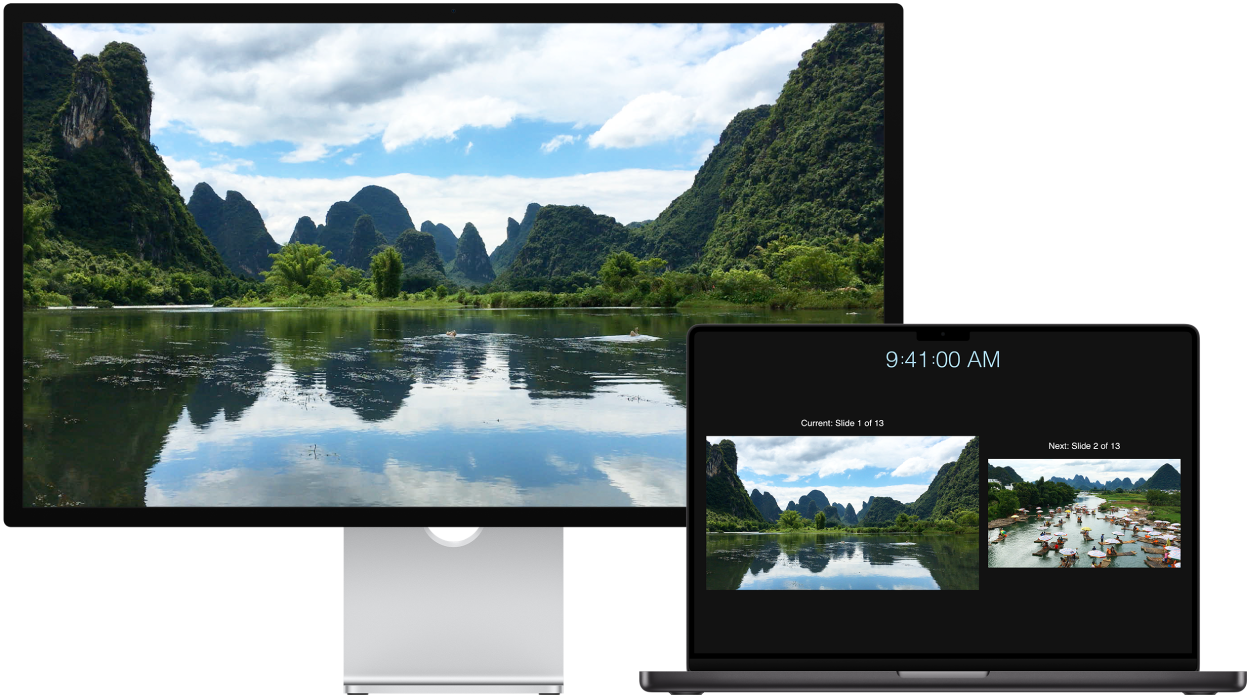Use an external display with your MacBook Pro
The HDMI and Thunderbolt ports on your MacBook Pro support video output, so you can connect an external display, a projector, or a high resolution TV.
MacBook Pro with M3. You can connect one external display with up to 6K resolution at 60 Hz using the Thunderbolt port or HDMI port.
MacBook Pro with M3 Pro. You can connect up to two external displays in the following configurations:
Connect one external display with up to 6K resolution at 60 Hz using a Thunderbolt port and one external display with up to 4K resolution at 144 Hz using the HDMI port.
Connect up to two external displays with up to 6K resolution at 60 Hz using the Thunderbolt ports.
You can also connect a single display with up to 8K resolution at 60 Hz or up to 4K resolution at 240 Hz using the HDMI port.
MacBook Pro with M3 Max. You can connect up to four external displays in the following configurations:
Connect up to three external displays with up to 6K resolution at 60 Hz using the Thunderbolt ports and one external display with up to 4K resolution at 144 Hz using the HDMI port.
Connect up to two external displays with up to 6K resolution at 60 Hz using the Thunderbolt ports and, using the HDMI port, either one external display with up to 8K resolution at 60 Hz or one external display with up to 4K resolution at 240 Hz.
To learn more about using an 8K display with your MacBook Pro, see the Apple Support Article Use an 8K display with your Mac.
If you’re not sure how many external displays your MacBook Pro supports, check your Technical Specifications. Open System Settings, choose Help > MacBook Pro Specifications, then locate Display Support (you may need to scroll).

Connect a display to MacBook Pro
Identify the ports on your MacBook Pro. Before you connect a display to your MacBook Pro, it’s useful to know what ports your Mac has. To familiarize yourself with the ports on your MacBook Pro and where they are located, see Take a tour of MacBook Pro. To learn more about different types of ports and what they do, see Identify the ports on your Mac.
Connect a display to a port on your MacBook Pro. You can connect the following displays and projectors to a port on your MacBook Pro:
Connect a VGA display or projector: Use a USB-C VGA Multiport Adapter to connect the display or projector to a Thunderbolt port on your MacBook Pro.
Connect an HDMI display: Plug a cable from your HDMI display directly into the HDMI port on your MacBook Pro.
Connect a USB-C display: Connect the display to a Thunderbolt port on your MacBook Pro.
Use an adapter to connect a display. If the cable for your display has a connector that doesn’t match the port you want to use, you may be able to use it with an adapter (sold separately). To learn more about adapters for your MacBook Pro, see Adapters for your MacBook Pro and Adapters for the Thunderbolt 4, Thunderbolt 3, or USB-C port on your Mac.
To purchase an adapter, you can visit apple.com, your local Apple Store, or other resellers for more information and availability. Review the display’s documentation or check with the display’s manufacturer to make sure you choose the right product.
Note: The MacBook Pro can support both Apple Pro Display XDR and Apple Studio Display. To set up, see the Apple Support articles Set up and use Apple Pro Display XDR and Set up and use Apple Studio Display.
Use an Apple TV with AirPlay. If you have an HDMI display connected to an Apple TV, you can use AirPlay to mirror your MacBook Pro screen on your TV screen. See Stream content on a larger screen with AirPlay for details.
After you have connected your display
Adjust and arrange displays. After you connect an external display or projector, go to System Settings and click Displays in the sidebar to set how the displays are arranged, choose which to use as your main display, and adjust resolution. If you want to mirror your screen, click the display that you want to act as a mirror, then choose the mirror option from the “Use as” menu.
Use a display while MacBook Pro is closed. After you connect an external display to your MacBook Pro, close the lid. You can continue to use your MacBook Pro with the connected display, as well as any connected accessories. To connect an accessory, see Use accessories with your MacBook Pro.
Troubleshooting. To troubleshoot an issue with an external display, see If your external display is dark or low resolution.
